|
|
| (1) Posted by Geoff Foster [Wednesday, May 7, 2008 10:56] |
Bruno Preziosi
The following is a unique achievement - a Zagoruiko mutate.
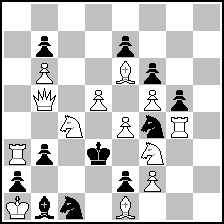 (= 13+11 ) (= 13+11 )
Bruno Preziosi, 1st Prize, Probleemblad, 1957
Set
1...Kxe4 2.Scd2
1...Kc2 2.Se3
1...Bc2 2.Sd6
1...Sf~ 2.Se3
Try
1.Qb4? (-)
1...Kxe4 2.Sce5
1...Kc2 2.Qd2
1...Bc2 2.Sb2
1...Sf~ 2.Qc3
1...Sxd5!
Key
1.Qc5! (-)
1...Kxe4 2.Qe3
1...Kc2 2.Sb2
1...Bc2 2.Qd4
1...Sf~ 2.Sb2
This problem is quoted in "Chess Problems: Tasks and Records", where Sir Jeremy Morse states that the composer is
known only for this problem. However, a certain database has 27 problems by Preziosi, most published between 1956-59,
including the following.
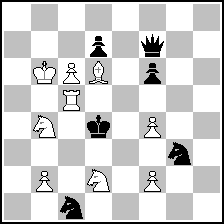 (= 9+6 ) (= 9+6 )
Bruno Preziosi, 1st Prize, L'Italia Scacchistica, 1959
Set
1...Se4 2.Sf3
1...Sd3 2.Sc2
Try
1.Re5? (2.Bc5)
1...Qc4 2.Sf3
1...Sd3 2.Sc2
1...Qe7,Qf8,Qd5 2.R(x)d5
1...Se4 2.Rxe4
1...Sb3!
Key
1.Rc3! (2.Bc5)
1...Qc4,Qe7,Qf8,Qh5 2.R(x)c4
1...Sd3,Sb3 2.R(x)d3
1...Se4 2.Sf3
1...Qd5 2.Sc2
In Oscar Bonivento's "Antologia dei Problemisti Italiani", published in 1964, there is no biography of this composer
and he is just represented with the Probleemblad problem. Can anybody provide any details about Preziosi?
|
|
| (2) Posted by Michael McDowell [Thursday, May 8, 2008 17:24] |
From “Nuova Antologia dei Problemisti Italiani” by Oscar Bonivento (1992)
Preziosi, Prof. Bruno
S.Angelo del Pesco (IS) 8.6.1931
Struttura della Materia. Nel 1955 Castellari si complimentava col suo discepolo, e a ragione. Se breve è stato il periodo di applicazione al problema, brillante è stato invece il risultato: 15 premiati su di una trentina pubblicati. Ottimi gli articoli sul cambio progressivo dei matti (vedi il Due Mosse, 1958). A quando il grande ritorno?
Maybe someone can translate.
|
|
| (3) Posted by Thomas Maeder [Thursday, May 8, 2008 18:04] |
"Structure of Matter. In 1955, Castellari congratulated his disciple, and for a reason. If the period of his problem activity was short, the result was brillant: 15 prizes for some 30 published problems. Very good articles on progressive changed mates (see Il Due Mosse 1958). When does the giant return?"
Now somebody please translate from English to English. :-)
|
|
| (4) Posted by Geoff Foster [Friday, May 9, 2008 02:11] |
The mention of "Structure of Matter" is interesting. It turns out that Professor Bruno Preziosi is a hugely important figure in physics in Naples! There are many references to him on the Internet. One article mentions how his career in physics from 1959 to the present day retraces the entire history of the physics of matter! It seems that around 1959 Preziosi gave up a brilliant career in chess problems to waste his time on physics.
|
|
| (5) Posted by Geoff Foster [Friday, May 9, 2008 10:56] |
I've managed to contact Professor Preziosi! He replied "I have no more interest although I try solve problems which appear in
l'Italia Scacchistica and I due Cavalli. In fact, from when I entered as researcher in the University of Naples, I have worked in physics problems with a certain success. Although I'm going to reach 77 years my mind is fresh enough."
|
|
| (6) Posted by Hauke Reddmann [Friday, May 9, 2008 12:22] |
"Known only for this problem":
I see no conflict in the formulation. I own the Morse book and
immediately recognized the problem itself but haven't remembered the
composers name. Q.E.D ;-)
Hauke
|
|
| (7) Posted by David Knezevic [Friday, May 9, 2008 13:12] |
Problems like this belong to the "Holly Grail" category: they guarantee the immortality for their authors. Like Babson task did for Leonid Yarosh.
Another "Holly Grail" in the mutate genre is a 6-change monster by Viggo Klausen. It deserves its own honours so, despite we all know the it very well, I'll quote it in another thread... such problems can never be "overquoted" :)
|
|
| (8) Posted by Michael McDowell [Friday, May 9, 2008 15:29] |
The Preziosi problem is basically a case of forcing an idea into the wrong form, resulting in an ugly setting and a dearth of possible keys. While admiring the ingenuity of the achievement, the main lesson I learn from it is that the Zagoruiko is a theme for free-change problems, not mutates.
As for Klausen - are we reduced to saying that most = best? (not that "best" is anything other than a personal opinion). Give me Mansfield's perfect 9-piece mutate from Morning Post 1923 any day. Artistry at its finest (another personal opinion!).
|
|
| (9) Posted by Ian Shanahan [Thursday, May 15, 2008 02:43] |
I think it's true to say that the Preziosi masterpiece is unique in being a "3x3 Zagoruiko mutate" - but we do need to be this specific, since there are other Zagoruiko mutates, in particular the Zagoruiko pioneer by G. F. H. Packer (1915)! NB: Packer's try carries a multiple threat, so that phase is a block-threat. However, Geoff himself told me about indisputable Zagoruiko mutates by Stocchi and (more recently) Gavrilowski. In general, I concur with Michael - though Packer's pioneer is rather elegant!
|
|
| (10) Posted by Geoff Foster [Thursday, May 15, 2008 12:50] |
As Ian said, there are other Zagoruiko mutates! This one was published in the same magazine as Preziosi's problem, but in the preceding year.
Ottavio Stocchi, 7HM, Probleemblad, 1956
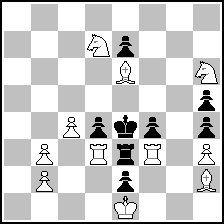 (= 11+8 ) (= 11+8 )
Set
1...Rxd3 2.Bd5
1...Rxf3 2.Bf5
Try 1.Sf5? (-)
1...Rxd3 2.Rxf4
1...Rxf3 2.Rxd4
1...Kxd3!
Key 1.Sf7! (-)
1...Rxd3 2.Sg5
1...Rxf3 2.Sc5
1...Kxd3 2.Bf5
1...Kxf3 2.Bd5
I'll post the other examples later.
|
|
| (11) Posted by Michael McDowell [Thursday, May 15, 2008 23:15] |
The Stocchi matrix is interesting. By abandoning mutate form Michael Lipton combined Zagoruiko and Rukhlis.
Michael Lipton
Commend, Problem 1960
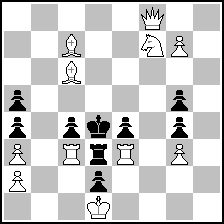 (= 11+9 ) (= 11+9 )
Mate in 2
Set:
1…Rxc3 2.Bb6
1…Rxe3 2.Be5
1…Kxc3 2.Be5
1.Se5?
1…Rxc3 2.Rxe4
1…Rxe3 2.Rxc4
1…Kxe3 2.Bb6
1…Kxc3!
1.Sd6!
1…Rxc3 2.Sf5
1…Rxe3 2.Sb5
1…Ke5 2.Rxe4
1…Kc5 2.Rxc4
1…Kxc3 2.Qf6
1…Kxe3 2.Bb6
|
|
| (12) Posted by Geoff Foster [Monday, May 19, 2008 06:56] |
Here is another Zagoruiko mutate.
Zoran Gavrilovski, 4HM, Wola Gulowska, 1999
 (= 9+8 ) (= 9+8 )
Set
1...Kf3 2.Qh5
1...f3 2.Qd3
1.Sd3? (-)
1...Kf3 2.Sg3
1...f3 2.Sf4
1...d1=Q/S!
1.Sb3! (-)
1...Kf3 2.Sd4
1...f3 2.Qxb5
1...d1=Q/S 2.Qxd1
|
|
| (13) Posted by Ion Murarasu [Monday, May 19, 2008 08:51] |
And one Zagoruiko with Grimshaw theme!!
Mircea MANOLESCU, Revista de Sah, 1956, 1st Prize
 (= 7+5 ) (= 7+5 )
set
1…Bc3 2.Se3‡
1…Rc3 2.Se5‡
try
1.Sf2? [2.Qb4‡]
1…Bc3 2.Qd3‡
1…Rc3 2.Qf4‡
mais 1…Rb3!
Sol.
1.Be3! [2.Rb4‡]
1…Bc3 2.Qé2‡
1…Rc3,Bd4 2.Q(×)d4‡
(1…Rd3 2.Qb4‡
1…Rb3 2.Rc5‡
1…R×e3 2.S×e3‡)
|
|
| (14) Posted by Paz Einat [Tuesday, May 20, 2008 01:27]; edited by Paz Einat [08-05-20] |
A search through WinChloe finds 36 mutate Zagoruiko's. There were some interesting finds, but I was shocked to find my own problem, intended as a simple two-mate changes mutate which I composed for the solving show in the 1999 meeting in Israel. It's not a straight 3x2 Zagoruiko but it's there I guess.
Paz Einat
The Problemist Supplement 2001
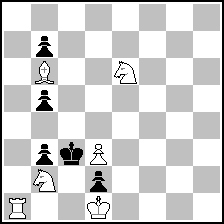 (= 6+5 ) (= 6+5 )
Solution as given in WinChloe
1…Kb4 2.Ba5‡
1…K×b2,b4 2.Bd4‡
1.Bd8? blocus
1…Kb4 2.Ba5‡
1…K×b2 2.Bf6‡
mais 1…b6!
1.Bé3? blocus
1…Kb4 2.B×d2‡
1…K×b2,b4 2.Bd4‡
mais 1…b6!
1.Bç7? blocus
1…Kb4 2.Ba5‡
1…K×b2,b4 2.Bé5‡
mais 1…b6!
1.Sf4! blocus
1…Kb4 2.Sd5‡
1…K×b2 2.Bd4‡
1…b4 2.Sa4‡
|
|
No more posts |
MatPlus.Net  Forum Forum  Twomovers Twomovers  Bruno Preziosi Bruno Preziosi |
 ISC 2024
ISC 2024 Forum
Forum  Twomovers
Twomovers  Bruno Preziosi
Bruno Preziosi 


